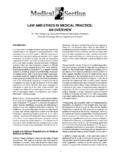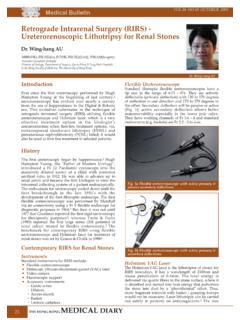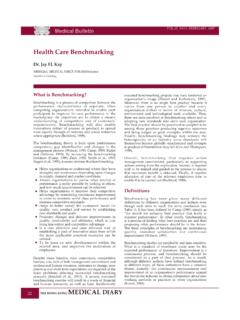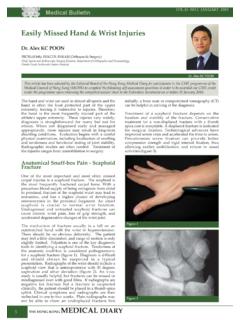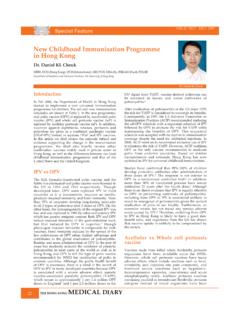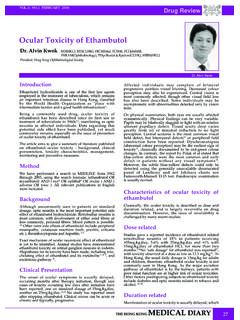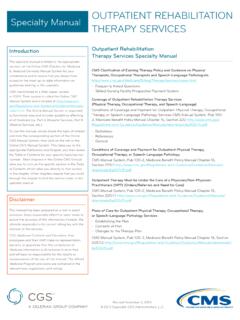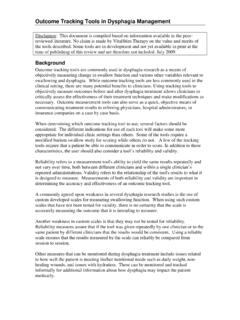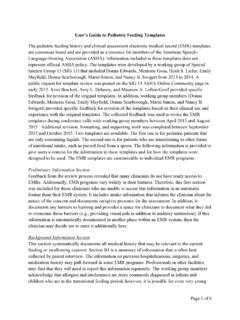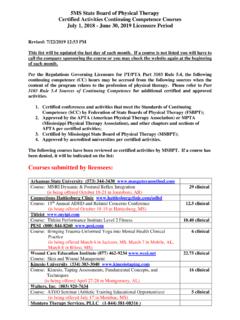Transcription of Management of Excessive Respiratory Secretions: A …
1 Palliative Medicine Doctors Meeting_____HKSPM Newsletter 2007 Dec Issue 3 p 16 Case histories contributed by Dr Ng Sheung Ching and Dr Ma Chi MingThe Story of Madam CMadam C, a 72-year old retired farmer, had been suffering from right biliary papillomatosis since 2003 with extended right hepatectomy performed. Extensive liver metastases were noted since 2006 and metastatic adenocarcinoma to left lung was detected in 2003. She refused chemotherapy and accepted palliative care. She complained of cough with profuse whitish mucoid sputum which had increased to over 300 ml per day. Oral hyoscine methobromide had been tried with initial improvement. However, the disease progressed and the sputum volume increased to around one liter per day causing dyspnea even at rest. A clinical diagnosis of bronchorrhea was made. Various medications including oral erythromycin 500 mg twice daily and oral indomethacin 50 mg twice daily were tried with no improvement in bronchorrhea but were complicated by nausea with erythromycin and impaired renal function with indomethacin.
2 Continuous subcutaneous infusion of hyoscine hydrobromide up to mg per day was given with no improvement in sputum volume but resulted in Excessive drowsiness. Continuous subcutaneous infusion of fentanyl and midazolam was needed to control her dyspnea and restlessness. Subsequently, continuous subcutaneous infusion of octreotide was given at a dose of 200-300 micrograms per day. There was significant improvement in the volume of Respiratory secretions , dyspnea, and restlessness. Subcutaneous hyoscine and midazolam infusions were stopped due to improvement in symptoms. Her alertness also improved. She subsequently died 10 days after commencement of octreotide infusion. The Story of Madam SMadam Sin, aged 48, was previously a trainer in a cosmetic and fitness center. She had a second marriage. She was diagnosed to have polymyositis in 1997 presenting with weakness.
3 Multiple immunosuppressive therapies had been tried including glucocorticoids, azathioprine, cyclophosphamide, cyclosporin, intravenous immunoglobulins, mycophenolate mofetil, and rituximab, but her disease progressed. She had an episode of severe pneumonia requiring intubation and subsequent tracheostomy. She was then transferred to the rehabilitation ward for convalescence. Upon admission, she was totally dependent in her daily living, and she needed non-oral feeding due to dysphagia. She was just able to move her eyes and fingers. Her main physical symptoms were Excessive saliva and sputum affecting her speech and eating, sense of suffocation due to secretions , pain and numbness over pressure points, and pain in multiple joints. Concerning her psychological state, she had a strong sense of helplessness due to repeated treatment failures and loss of independence, fear of dying from suffocation, sense of loneliness due to infrequent visits from her family, and anger and frustration about her physical needs not being promptly addressed by staff.
4 She frequently called for help with dramatic gestures and repeated call bells ringing. The multidisciplinary team attempted to address her multiple needs. The physiotherapist performed vigorous chest physiotherapy and hand function enhancement exercises; the occupational therapist designed a special chair and a foot platform to facilitate her sitting out; the speech therapist provided speech training; the clinical psychologist enhanced her self expression by drawing; the chaplain and some volunteers provided religious, spiritual and social support; and the social worker assisted her in hiring a maid to take care of her in the Management of Excessive Respiratory secretions : A Sharing of Two Patients StoriesDr Lam Wai Man, Haven of Hope : Medicine Doctors Meeting_____HKSPM Newsletter 2007 Dec Issue 3 p 17and the nurses educated her on performing self suction of saliva.
5 The doctor tried many medications to manage her saliva secretions including oral promethazine, oral amitriptyline, and inhaled ipratropium, but they were not injection of Botulinum toxin (Botox) 15 Units into each submandibular gland, was performed under ultrasound guidance. It was effective in reducing the volume of saliva secretions by about 70% at one week after injection. The tracheostomy was successfully weaned off. She became less anxious, more talkative and expressive. She survived for six more months after Botox injection with no recurrence of Excessive salivation, and she died of acute myocardial infarction and hospital acquired Management of BronchorrheaBronchorrhea is arbitrarily defined as watery sputum production of over 100 ml per Up to 9 Liters per day has been It can be caused by primary lung malignancy especially of bronchioloalveolar cell type and metastases to lung especially from cells of glandular origin ( adenocarcinoma of cervix, colonic adeno- carcinoma, and pancreatic cancer).
6 3, 4, 5 It can also be caused by non-malignant conditions like chronic bronchitis, asthma, and endobronchial are three postulated pathophysiological mechanisms for bronchorrhea: 1. Hyper-secretion of mucus-glycoprotein and other glandular products from mucus- glycoprotein producing cells neutrophils accumulating in airway mucosa may stimulate goblet cells Increased transepithelial chloride secretion- this can be mediated by receptors for prostaglandins (PGE2, PEF2 ) or secretin in the bronchial Excessive transudation of plasma products into the airway. 6 Bronchorrhea has negative impact on both survival and quality of life. It can cause Excessive cough, sleep disturbance and dyspnea. When severe, it may lead to Respiratory failure, dehydration and electrolyte disturbance. The Management of bronchorrhea includes general supportive measures to promote comfort, maintenance of fluid and electrolyte balance, and measures to reduce bronchial secretion production.
7 The following seven entities have been tried in reducing bronchial Secretions: 1. Radiotherapy and traditional chemotherapy2. Anticholinergic agents3. Macrolides4. Pulsed methylprednisolone5. Inhaled indomethacin6. Gefitinib (EGFR-TKI)7. OctreotideThe responses of bronchorrhea to radio- therapy, traditional chemotherapy, and anticholinergic drugs are variable. Macrolides act by affecting neutrophil migration and activities in the lung and inhibiting the synthesis and secretion of a mucus secretogogue from pulmonary There were case reports of using oral clarithromycin combined with inhaled beclomethasone in managing bronchorrhea in alveolar cell carcinoma,8 pulsed methylprednisolone in a patient with bronchiolo- alveolar carcinoma (BAC),9 and inhaled indomethacin in patients with chronic airway diseases like chronic bronchitis, diffuse panbronchiolitis and bronchiectasis, presumably by reducing the levels of prostaglandins and its metabolites in Nebulised indo- methacin was successful in two patients with BAC suffering from bronchorrhea in reducing the sputum volume, improving the quality of life, and possibly prolonging the survival.
8 11 Two more recent weapons in treating bronchorrhea are Gefitinib and Octreotide. Gefitinib, an Epidermal Growth Factor Tyrosine Kinase Inhibitor, is thought to reduce bronchorrhea by inhibiting the expression of a major mucin in BAC cells, the MUC5AC mucin, based on findings from animal study and laboratory setting. 12, 13 There were case reports of its successful reduction of sputum volume in BAC , 15 As the onset of improvement occurred within 24 hours of use, it is likely that its inhibitory action on mucin production is independent of its anti-proliferative , a somatostatin analogue, has been reported to significantly reduce the volume of secretions in a lady with the acinar type of Palliative Medicine Doctors Meeting_____HKSPM Newsletter 2007 Dec Issue 3 p 18adenocarcinoma of lung at a dose 300-500 micrograms It is postulated to have an inhibitory action on the secretin receptors in the bronchial tree.
9 The patient we presented above further substantiates its potential role in Management of SialorrheaNormal adults produce 750 to 1500 ml of saliva per day. Unlike bronchorrhea which is usually the result of Excessive secretion, sialorrhea is usually due to oropharyngeal dysphagia and impaired cough effort caused by various neurological diseases, or esophageal dysphagia caused by mechanical obstruction or esophageal dysmotility. Sialorrhea may affect feeding, interfere with speech, lead to social embarrassment, induce sense of suffocation with resultant fear, and increase susceptibility to aspiration Management of Excessive oropharyngeal secretions comprises of physical modalities, medications, irradiation to salivary glands and various surgical (Table 1)Surgical techniques are limited by its irreversibility and patients fitness for surgery.
10 Anticholinergic drugs and antidepressants are limited by their side effects. Radiation to salivary glands may be complicated by development of head and neck malignancies in the long run. There are case reports of the usefulness of local botulinum toxin injection into salivary glands in patients with head and neck cancer, neurodegenerative disorders, and stroke with no reported side effects. 18, 19 Randomized controlled studies have also proven its efficacy. (Table 2)20 The clinical aspects of botulinum toxin injection have also been It can be injected into parotid glands, submandibular glands, or both. The injections can be guided by anatomical landmarks or ultrasound localization of the salivary glands. Use of ultrasound leads to a higher success rate and fewer side effects, and the dose used can be lower. However, it requires certain expertise. The dosages reported varied from 5-75 U into each parotid gland and 5-30 U into each submandibular gland.

